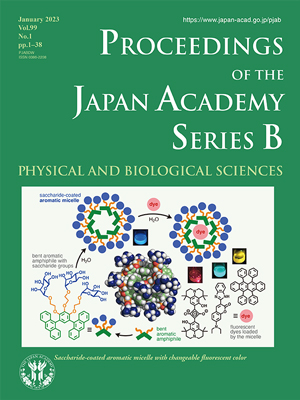About the Cover
Vol. 99 No. 1 (2023)
Micelles are assemblies of amphiphilic molecules. They have intriguing relevance to various aspects of human life. For example, protocells are associated with the origin of life and soaps and detergents were regularly used from ancient times. Amphiphiles comprise hydrophobic and hydrophilic moieties, whose structural differences divide micelles into two prototypes. Type 1 amphiphiles, representing the majority, possess linear alkyl chains as the hydrophobic part and aggregate into roughly spherical particles owing to the hydrophobic effect. The basic properties of such alkyl chain-based micelles and their applications have been studied extensively. In contrast, type 2 amphiphiles comprise hydrophobic and hydrophilic polymer chains, generating polymeric assemblies with spherical core-shell structures. Compared with the type 1 micelles, polymer micelles display excellent stability toward higher dilution and increased temperatures in water.
Unlike these two classic micelles, Yoshizawa et al. reported new capsular micelles with multiple polyaromatic panels in 2013 for the first time. The group calls these novel molecular assemblies “aromatic micelles” to distinguish them from previous micelles. They synthesized a bent aromatic amphiphile with two anthracene panels and two trimethylammonio groups. Upon exposure to water, the new amphiphiles assemble spontaneously and quantitatively to form an aromatic micelle with a spherical polyaromatic shell. Owing to the combination of the hydrophobic effect and π–π interactions, the resultant micelle displays relatively high stability and narrow size distribution. Importantly, the aromatic micelle can efficiently incorporate various hydrophobic dyes into the cavity in water through efficient host–guest interactions. Its uptake ability is much higher than that of conventional micelles. Fluorescent compounds, nanocarbons, and π-conjugated metal-complexes are also incorporated by the aromatic micelle.
Owing to their characteristic structures and superior host abilities, these third-generation micelles display unique functions in water. This review by Yoshizawa and Catti describes their recent achievements with aromatic micelles: stimuli-responsive aromatic micelles, aromatic oligomer micelles, saccharide-coated aromatic micelles, and related cyclohexyl/adamantyl-based micelles (see the article in this issue, pp. 29-38).
Keisuke Suzuki
Member of the Japan Academy




